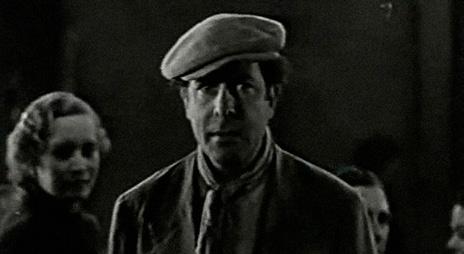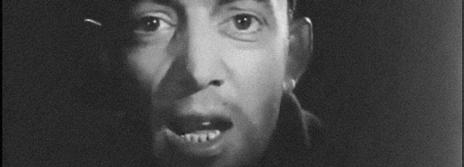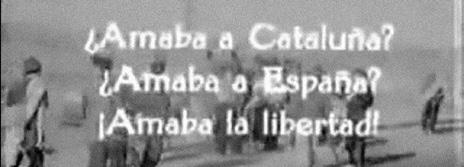
9 minute read
Guerrilleros del cinema: cine anarquista español
MUESTRA CINE Y RESISTENCIA CINEMA AND RESISTANCE SELECTION
GUERRILLEROS DEL CINEMA CINE ANARQUISTA ESPAÑOL: A LA VEZ POPULAR E IDEOLÓGICO LUIS PARÉS
Advertisement
En todas las épocas ha habido cineastas que han querido poner las películas al servicio de la creación de un mundo mejor. Pero a pesar de su noble propósito, muchas veces han quedado en los márgenes de los libros. Dentro de la historia del cine, el cine militante siempre se ha mantenido un poco escondido, como el primo alocado e idealista al que se le hace poco caso en las fiestas familiares. Y en la historia del cine militante, el ciclo de cine anarquista producido en España durante la Guerra Civil es directamente ignorado, una anécdota que apenas ocupa dos líneas. Sin embargo, hoy, a la luz de las movilizaciones sociales que se suceden en todo el mundo y viendo las películas que registran esos movimientos, las propuestas cinematográficas de la Confederación Nacional del Trabajo (CNT) de España deberían estar más vigentes que nunca.
Durante ese breve verano de la anarquía que fueron los dos primeros años de la Guerra Civil española, el movimiento anarcosindicalista prestó al cine una atención predominante, siendo el único bando en la guerra que tuvo una política cinematográfica firme y organizada. Los anarquistas supieron desde el primer momento que el cine era el mejor instrumento para la pedagogía y la concienciación. Así, el día 22 de julio de 1936, apenas cuatro días después del alzamiento militar, se estrenaba en salas la película Reportaje del movimiento obrero en Barcelona, que narraba la lucha de la ciudad contra la sublevación. A esa película la siguieron, al menos, 104 títulos. El objetivo estaba claro: el cine podía llevar la lucha revolucionaria del frente más lejos, podía concientizar a más personas.
Pero lo importante no es la cantidad, sino el hecho de que la producción anarquista se dio cuenta de que un verdadero cine revolucionario tenía que ser también revolucionario en su forma. Así, a los documentales de registro también le sucedieron películas de montaje, ficciones híbridas, primitivos cinetracts e incluso ficciones populares. Desde el musical infantil al sainete costumbrista, los directores anarquistas no dejaron de intentar hacer un cine que fuese a la vez popular e ideológico. La revolución cinematográfica anarquista no se redujo solo a la producción de películas. Las salas de exhibición, los laboratorios, los estudios, las distribuidoras, todos los estamentos del negocio fueron colectivizados y puestos al servicio de otro tipo de cine, de otro tipo de sociedad.
Entender y comprender ese movimiento hoy, cuando tantos cineastas intentan instalar sus propios canales de creación y difusión del cine político, es un ejercicio que trasciende la arqueología y la historiografía para incorporarse al puro gozo del descubrimiento de una joya, del hallazgo de un cine moderno, eterno, que hunde sus raíces en la concepción utópica de un mundo compuesto por iguales.
CINEMA AND GUERRILLA SPANISH ANARCHIST CINEMA: BOTH POPULAR AND IDEOLOGICAL LUIS PARÉS
There have always been filmmakers who want movies to serve the purpose of building a better world. But in spite of their noble goal, often have they been relegated to the margins. Within the history of cinema, militant cinema has always been kept somewhat hidden, like the wild and idealist cousin who doesn’t get much attention at family gatherings. And within the history of militant cinema, anarchist films produced in Spain during the Civil War have been largely overlooked, an anecdote that barely takes up a couple of lines. Today however, and in light of the social demonstrations taking place around the world and the films that register such movements, the cinematographic proposals of Spain’s National Labor Confederation (CNT) should be more relevant than ever.
During the brief summer of anarchy, i.e. the first two years of the Spanish Civil War, the anarchosyndicalist movement paid close attention to cinema: It was the only side of the war that had an organized and strong cinema policy. Anarchists new from the very beginning that cinema was the best tool for teaching and raising awareness. Thus, on July 22, 1936, just four days after the military uprising, the film Reportaje del movimiento obrero en Barcelona made its debut in the theater, narrating the city’s struggle against the rebellion. This movie was followed by at least 104 films. The goal was clear: Cinema could take the front’s revolutionary struggle even further; it could serve to raise awareness among a broader audience.
Numbers are not what matters, but the fact that anarchist productions realized that a true revolutionary cinema should also be revolutionary in its form. Thus, report documentaries were followed by edited films, hybrid fictions, rough cinetracts, and even popular fictions. From children’s musicals to comedy of manners, anarchist directors were continually attempting to make a cinema that could be at the same time popular and ideological. The anarchist cinematographic revolution was not only involved with the production of motion pictures. Exhibition venues, labs, studies, distributors, and every level of the business were made collective and fit to serve the purpose of a different type of cinema, a different type of society.
To understand this movement today –when so many filmmakers are trying to establish their own creation and dissemination channels of political cinema– is an exercise that goes beyond archeology and historiography to engage in the pure thrill of discovering a jewel, of finding a modern and eternal cinema that has its roots in the utopian notion of a world made up of equals.
AURORA DE ESPERANZA
ESPAÑA, 1937
58 min // H264 IO: Español / Spanish
D G Antonio Sau Olite F Adrien Porchet M Jaime Pahissa I Félix de Pomés, Enriqueta Soler, Román González “Chispita”, Ana María Campoy

El primero de los largometrajes de ficción producidos por la Confederación Nacional del Trabajo (CNT) es también el más “social” y el más directamente político (los otros persiguen la creación de un cine popular de calidad). La película está llena de referencias al desempleo y a la necesidad de unir fuerzas en sindicatos.
The first feature-film produced by the Spanish National Confederation of Labor (CNT) is also the most social and political in nature (the other films pursue the creation of a quality people’s cinema). The film is plagued with references to unemployment and the need to join forces within unions.
Fundación Anselmo Lorenzo cultura@cnt.es
REPORTAJE DEL MOVIMIENTO OBRERO EN BARCELONA
ESPAÑA, 1936
22 min // H264 IO: Español / Spanish
D G Mateo Santos F Ricardo Alonso
Documental realizado con la resistencia de los anarquistas tres días después del levantamiento popular de Franco. Se ven las trincheras y las calles tomadas por los obreros, además de imágenes impactantes de la partida hacia el frente de Aragón.

Documentary about the anarchist resistance three days after Franco’s uprising, with footage of trenches, streets taken by workers, and remarkable images of Republicans leaving for the Aragon front.
BARCELONA TRABAJA PARA EL FRENTE
ESPAÑA, 1936
22 min // H264 IO: Español / Spanish
D G Mateo Santos F Roberto Porchet
Reportaje sobre cómo se lleva a cabo la colectivización de la industria alimentaria y se gestionan los espacios públicos devolviéndolos al pueblo. Impresionantes imágenes de los salones del Hotel Ritz convertidos en comedor popular.

Report on the collectivization of the food industry and how public spaces are returned to the people. Striking images of the Ritz Hotel halls transformed into soup kitchens.
BAJO EL SIGNO LIBERTARIO
ESPAÑA, 1936
15 min // H264 IO: Español / Spanish
D G Les (Ángel Lescarboura Santos) F D. García.
Crónica de la toma de un pueblo de Aragón y de la creación del socialismo libertario.

Chronicle of the taking of an Aragon town and the establishment of libertarian socialis
THE MASS TRIBUTE TO BUENAVENTURA DURRUTI
ESPAÑA, 1936
10 min // H264 IO: Inglés / English
Anónimo / Anonymous
I Emma Goldman (narradora/narrator)
Imágenes del entierro multitudinario de Durruti, quizá el acontecimiento más importante de la Guerra Civil, que prueba el arraigo popular que tenía el movimiento anarquista en España.

Footage of the massive crowds attending Durruti’s funeral, perhaps the most important event of the Spanish Civil War and which proves the strong grassroot support of Spain’s anarchist movement.
EL FRENTE Y LA RETAGUARDIA
ESPAÑA, 1937
21 min // H264 IO: Español / Spanish
D Joaquín Giner G Carlos Martínez Baena, Ramón Oliveres
Mediometraje de propaganda que combina imágenes reales de producción industrial y agraria con escenas ficcionales de combates en el frente de Aragón.

Propaganda medium-length that mixes actual footage of industrial and farm production with fictional scenes of combats in the Aragon front.
LA SILLA VACÍA
ESPAÑA, 1937
17 min // H264 IO: Español / Spanish
D G Valentín R. González F Félix Marquet I José Pal Latorre
Documental particularmente interesante porque no solo reconstruye situaciones diversas, sino que, por primera vez, se añade un pequeño hilo argumental a modo de pretexto para que la cámara nos guíe. Es un intento de complejizar y enriquecer la fórmula del documental para superar el reportaje funcional.

Particularly interesting documentary because, in addition to reconstructing different events, for the first time a thin storyline is introduced as an excuse for the camera to guide us. It is an attempt to add complexity and develop the documentary formula in order to outgrow functional reports.
EN LA BRECHA
ESPAÑA, 1937
17 min // H264 IO: Español / Spanish
D Ramón Quadreny G Carlos Martínez Baena, Ramón Oliveras F José de la Mata S Rosendo Sagrera E Antonio Canovas I María Alcaide, Joaquín Pujol Mezcla de ficción y documental que muestra el funcionamiento de una empresa colectivizada.

A combination of fiction and documentary to show the operation of a collectivized business.
EL ÚLTIMO MINUTO
ESPAÑA, 1936
7 min // H264 IO: Español / Spanish
D G J. Bosch Ferrán F Pablo Wescheuk (Willy) M C. Bernat
Documental ficcional sobre la necesidad de tomar partido y de alistarse, con imágenes alegóricas de una gran potencia.

Fiction documentary about the need to get involved and enlist, with extremely powerful symbolical footage.
20 DE NOVIEMBRE DE 1936 ¿TE ACUERDAS DE ESTA FECHA, COMPAÑERO?
ESPAÑA, 1937
3 min // H264 IO: Español / Spanish
Anónimo / Anonymous
Filme de montaje que conmemora la vida del héroe anarquista Buenaventura Durruti en el primer aniversario de su muerte.

A montage film that honors the life of anarchist hero Buenaventura Durruti in the first anniversary of his death.
Fundación Anselmo Lorenzo cultura@cnt.es
NOSOTROS SOMOS ASÍ
ESPAÑA, 1937
30 min // H264 IO: Español / Spanish
D G Valentín R. González F Jaime Piquer M Pascual Godes, Jaime Mestres I Miguel Ángel Navarro, Manuel Jiménez, Joaquín Regales, Salvador Arnaldo, Lolita Domínguez, Carmen Campoy

Una de las joyas más raras del cine anarquista. Un musical infantil sobre la necesidad de vencer prejuicios con una niña parecida a Shirley Temple. One of the rarest gems of anarchist cinema. A children’s musical about the need to overcome prejudices with a girl who looks like Shirley Temple.
Fundación Anselmo Lorenzo cultura@cnt.es







